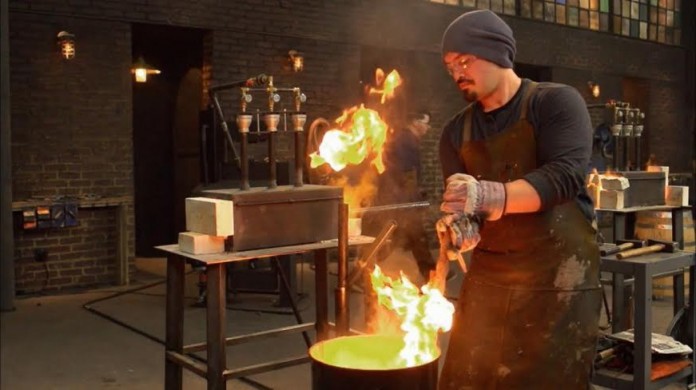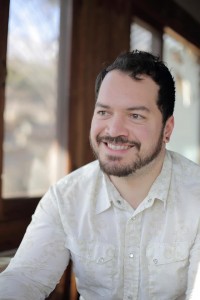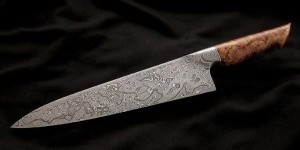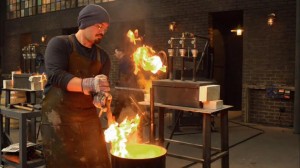
By Nikki McCoy
 There’s an old auto repair shop in Tumwater, just behind Pints Barn. The former garage is filled with out-of-order arcade games, beer signs, and a full forge shop, where Mareko Maumasi, owner of Maumasi Fire Arts, builds masterpieces.
There’s an old auto repair shop in Tumwater, just behind Pints Barn. The former garage is filled with out-of-order arcade games, beer signs, and a full forge shop, where Mareko Maumasi, owner of Maumasi Fire Arts, builds masterpieces.
When I arrive for our interview, Mareko is watching a hunk of steel glow in a 2,200 degree kiln. He then manipulates the metal with the blows of a 5-pound hammer. Then back in the kiln it goes.
This is just a small piece of the intensive process of knifemaking. Designing, hammering, hydraulic pressing, grinding and forging are just a few more. It’s hard work, but Mareko has the eye, and the passion.

“It’s hard to nail down exactly what my favorite part is,” says Mareko. “I love experiencing the whole process from conceptualizing to having a finished real world product in your hand that’s ready to be used.”
Mareko specializes in culinary knifes, using an ergonomic blend of form and function. Inspired by water, his Damascus techniques (alternating layers of steel and iron, folding and twisting the metal during the forging process) are intricate and detailed, complimented by shape and style of wooden handles.
The 30-year-old Olympia High School graduate has worked intensively with professionals on both coasts, and in 2014 (his first year of competition) Mareko brought home four awards, including People’s Choice and Best Chef’s at the Seattle International Knife Show.
It’s this experience and skill that caught the attention of History Channel producers, and Mareko was invited to compete in the network’s new show, “Forged in Fire.”
The premise of the show is four world-class bladesmiths, with a variety of skill and specialty, compete in time-based challenges to create iconic edged weapons from history. On a recent episode, the two finalists had five days at their home forge to recreate a Rapier, one of the most revered pieces of weaponry during the Elizabethan era.
Smaller competitions are also held, such as designing and forging a blade of choice in three hours, using only the materials and equipment on set.
Whether a competitor is ready or not, the blades are then tested and assessed by a panel of expert judges, including a weapons historian, a Mastersmith with more than 20 years under him, and a hand-to-hand combat specialist. Testing techniques include slicing racks of meat to test for sharpness, or stabbing into steel car doors or ballistics dummies for strength and depth. Based on blade performance, competitors are eliminated. The last man to make the “cut” will win $10,000.
Mareko was flown to Brooklyn, New York for filming. And while he says the subway system was mildly intimidating, Mareko was grateful for the chance to travel, learn and meet new people, specifically the other craftsmen.
“We all got along really well and kind of banded together,” he says. “We all keep in contact with each other.”
Mareko is pleased the show is gaining popularity and appreciates the growing awareness around knifemaking.

In the U.S., he says, most cutleries come from factories in Asia and Europe.
“The amount of people that are doing this in the country is just a tiny speck of the population,” states Mareko. “There are only a total of about 300 certified Journeyman Smiths and Master Smiths in the world.”
It took a move to Colorado, where Mareko was pursuing culinary arts, to see that he wanted to get back into bladesmithing, and become part of that unique population.
“I had gone away from it and thought I was going to get into food,” he explains, “but while I was there, I found myself continually thinking about knives – how to improve on the ones I was using, design ideas, as well as Damascus patterns – thinking of patterns I didn’t see anywhere and wanting to create them. I have notebooks full of drawings – I call them my recipe books.”
It wasn’t long before Mareko moved back to Olympia. With his knowledge of culinary knifes, and his passion for bladesmithing growing, it was a natural progression for Mareko to open his own shop.

Now, the 5-year plan is to expand into a space where he can start teaching and demonstrating, as well as allowing other fire-workers access to their arts, like welding, metal sculpture, ceramics, glass and blacksmithing.
“Olympia is all about nostalgia for me. It has such an incredibly rich history that you can walk around and still see today,” says Mareko. “This is where I grew up, where I first fell in love, where I first learned how to sail, where I discovered my passion for food and later my passion for knifemaking. This is my home and where my community of friends and family live. I don’t know if it’s the water, or what, but it certainly has my heart.”
“Learning this trade has changed my life and has helped me to discover so much about myself,” he elaborates. “I want to create that opportunity for others. It’s a chance to draw more attention and interest to this city as well as enrich the culture of creativity and art here. It’s my opportunity to try and give back.”
While Mareko can’t disclose the outcome or process of his episode, his does invite the public to watch a demonstration of his bladesmithing, see cutlery prototypes, and ask questions at a pre-viewing party in his shop Monday, August 3 at 5:30 – 8:00 p.m. Following the demonstration will be the premiere of his episode at Pints Barn at 10:00 p.m.
The work is so visually driven, says Mareko, that he invites you to follow him on Instagram, @maumasifirearts, where you can see the wonders of this worldly craft. Or check out Maumasi Fire Arts on Facebook and Twitter.


















































